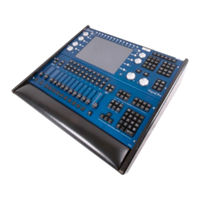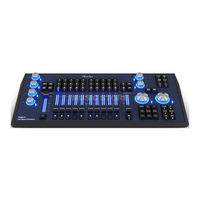ChamSys MagicQ Manuals
Manuals and User Guides for ChamSys MagicQ. We have 2 ChamSys MagicQ manuals available for free PDF download: User Manual, Installing And Using
ChamSys MagicQ User Manual (328 pages)
Brand: ChamSys
|
Category: DJ Equipment
|
Size: 7 MB
Table of Contents
-
-
Show Storage21
-
Cues22
-
Cue Stacks23
-
Playbacks23
-
Pages23
-
Help25
-
-
-
Connections26
-
Plugging up27
-
Powering up28
-
-
Windows31
-
Head Control32
-
Playback33
-
-
Items34
-
Naming Items35
-
Moving Items35
-
-
-
-
Patching42
-
Adding in FX49
-
5 Patching
52-
-
Head Names54
-
Head Numbers54
-
-
-
-
Using Groups68
-
Head Macros70
-
Flip73
-
Fan Mode76
-
And Only77
-
8 FX Engine
78-
Adding in FX78
-
FX Add Modes79
-
FX Parts80
-
FX Segments80
-
Pulse Width82
-
Flicker FX82
-
Multiple FX83
-
Changing FX84
-
Blocking FX84
-
Palette FX85
-
-
9 Palettes
86-
-
Using FAN90
-
-
-
-
View Simple94
-
-
Fade Type95
-
-
Active98
-
-
Heads View101
-
Intensity View101
-
Movement View102
-
Plan View103
-
-
12 Editing Cues
105 -
13 Cue Stacks
108-
Cue Stack Window108
-
Chase Timing108
-
Cue Timing109
-
The Halt Field110
-
Tracking110
-
Cue Only113
-
Mark Cues113
-
Linked Cues115
-
Cue Stack Macros116
-
Timeline117
-
-
14 Playback
118-
Playback Display118
-
Fader Control119
-
Playback Buttons119
-
Add / Swap120
-
Page Select120
-
Current Playback120
-
Manual Control121
-
Goto121
-
Rate Sub-Master122
-
Tap to Time122
-
Playbacks Window122
-
Naming Playbacks123
-
Playback Rate124
-
Wing Playbacks124
-
Set Lists125
-
-
-
HTP Handling126
-
LTP Handling127
-
Playback Mode130
-
-
Faders130
-
Buttons132
-
Flash Toggles133
-
Go Stop/Starts134
-
Stop Swaps134
-
Function134
-
Activate/Release136
-
Release Time136
-
Activate136
-
Release137
-
Advanced137
-
Chase Options139
-
Skip First Times139
-
Speed139
-
Xfade139
-
Direction139
-
Repeat Type139
-
Running140
-
-
Chase Times140
-
Audio140
-
-
Default Speed143
-
Default in Fade143
-
Default out Fade143
-
-
-
-
Adding in New FX146
-
Busking Master147
-
-
Starting up148
-
Shutting down148
-
Saving Shows148
-
Loading Shows149
-
Erasing149
-
File Manager151
-
Status Window152
-
Editing Heads152
-
Backup Archives152
-
Magicq Profiles153
-
-
19 Settings
155-
Programming Mode155
-
Playback Mode156
-
Output Settings156
-
Using Art-Net II158
-
Hot Take-Over160
-
Wing Settings161
-
Monitor Settings163
-
-
Product Type165
-
Country165
-
Time Zone165
-
Latitude165
-
Longitude165
-
Disable Macros166
-
Auto Backup166
-
Show File Path166
-
-
-
Windows Settings173
-
Subnet Mask179
-
-
Magicdmx Mode181
-
Serial COM Port181
-
Serial Baud Rate181
-
Serial Parity181
-
-
Wireless Key181
-
Serial Data Bits182
-
Serial Stop Bits182
-
Audio Input183
-
Monitor Settings183
-
-
Encoder Damping185
-
Touch Screen185
-
Encoders185
-
Screen Save186
-
Standard Logging186
-
Extended Logging187
-
General Settings187
-
LED Brightness188
-
Button Test Mode188
-
-
-
-
Demo Shows191
-
Touch View192
-
21 Automation
193 -
-
Design View197
-
Full Screen View198
-
Faders198
-
Buttons198
-
Wallpaper199
-
Automated Start199
-
-
23 Head Editor
200-
General View201
-
Channels View202
-
Ranges View204
-
Importing Ranges205
-
Capturing Ranges205
-
Attribute Test205
-
-
Palettes View205
-
Attribute Test206
-
Macros View206
-
Icons207
-
User Icons207
-
24 FX Editor
211-
View General211
-
View Chans211
-
Palette FX212
-
-
-
Pixel Mapper216
-
Media Priority217
-
Inbuilt Bitmaps218
-
Movie Support218
-
Colour Mixing226
-
Apply Type226
-
-
Thumbnail View236
-
Live Previews236
-
Troubleshooting237
-
-
Hot Take-Over246
-
Zoning252
-
-
MIDI Support275
-
MIDI Transmit275
-
MIDI Receive277
-
Remote Commands280
-
MIDI Problems280
-
-
-
-
Capture297
-
Wysiwyg299
-
-
Running WYSIWYG301
-
Running the Show301
-
Auto Patch302
-
Auto Focus302
-
Troubleshooting303
-
-
ESP Vision303
-
41 Handy Hints
306 -
-
Saving / Loading307
-
Patching307
-
Select Heads307
-
Playback308
-
Recording Cues309
-
Editing Cues309
-
Palettes309
-
Console310
-
Cue Stack Macros310
-
-
45 Licensing
324 -
46 Glossary
325
Advertisement
ChamSys MagicQ Installing And Using (4 pages)
Table of Contents
Advertisement

